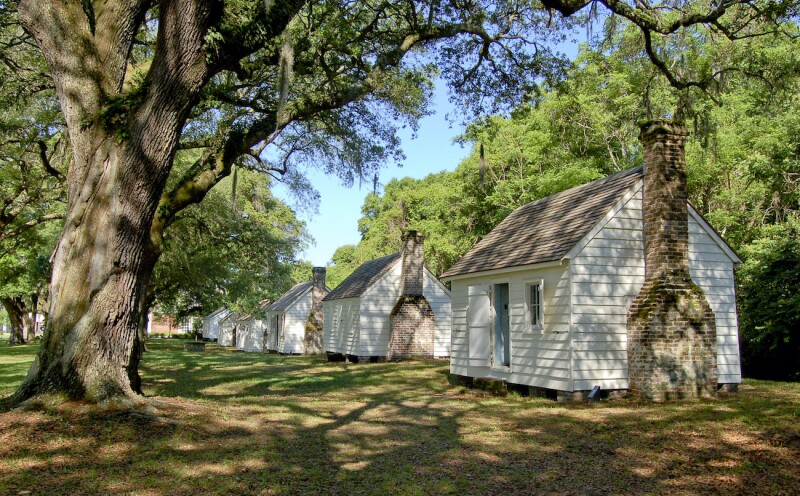It’s no secret that Charleston and its most beautiful estates have a complicated past. With 40 percent of all the enslaved who were brought to America coming through the Holy City, many ended up at the plantations that are now historic destinations. Traditionally, plantation tours focused on the opulence of the houses and tended to highlight the perspectives of wealthy white inhabitants. Today, this is changing, as nearly all the plantation sites in the Charleston area feature tours of slave quarters, African American history exhibits, and immersive Gullah Geechee culture programs, a distinctive group of African Americans whose ancestors were enslaved in the Lowcountry.
Because of these educational, contemplative experiences, visiting Charleston’s plantations can feel more rewarding and insightful than ever before. Walk in the footsteps of the enslaved and see where they slept, worked, and worshiped. Listen to moving stories and songs from true descendants of the Gullah Geechee people. Visit the headquarters for the Freedmen’s Bureau, an important early Reconstruction agency that worked to secure the freedom of African Americans. Here are some ways you can discover the full history behind Charleston’s plantations, while honoring the people who were enslaved there.

Boone Hall Plantation
Christopher Shane 2014
Experience Gullah Geechee culture with the people who know it best
The only plantation in Charleston to offer a live exploration of Gullah Geechee culture, Boone Hall Plantation helps to preserve these distinctive, meaningful traditions. During the presentation, Gullah Geechee descendants share their history, allowing guests to experience their enlightening and moving storytelling, song, and dance firsthand.
A visit to Boone Hall also provides an in-depth look at the lives of the enslaved and African Americans. Its Black History in America exhibit, staged throughout nine of the estate’s historic dwellings, illustrates different periods from slave ships arriving to the struggle for civil rights up to present day. While touring the sprawling grounds, visitors have an opportunity to witness the living quarters, historic relics, and lifestyle of the enslaved who lived at Boone Hall, in addition to house tours and the stunning Avenue Of Oaks, a three-quarter mile stretch of 270-year-old giant live oaks draped with Spanish moss.
Discover the unabridged truth of an important heritage site
Established in 1851, McLeod Plantation Historic Site is an award-winning Gullah Geechee heritage site, carefully preserved in recognition of generations of enslaved people. Originally a 1,693-acre labor camp, the estate has played many roles, including hospital for the Confederates, burial ground for Union soldiers, and headquarters for the Freedmen’s Bureau. Today, the 37-acre plantation hosts guided interpretive tours that illuminate the lives of the men, women, and children who lived and worked here before and after slavery.
Most of all, McLeod focuses on the African Americans who lived on the property well into the late 20th century. Compare the McLeod family home with those built for enslaved families, explore the meaning of spirituality in the lives of McLeod Plantation’s residents, and trace the emergence of Gullah culture in the Lowcountry.

McLeod Plantation Historic Site
Explore the African American history of three different plantations
Spend your day outside of downtown Charleston visiting these three neighboring plantations that are just down the road from one another. Drayton Hall, built in 1738, is the oldest unrestored plantation house in America still open to the public. With no plumbing, electric lighting, or furnishings in the main house, it allows a rare opportunity to appreciate the original architecture of a late 18th-century home. Visitors to Drayton Hall can view an interactive exhibit on Black history, the largest documented African American cemetery in North America (and the oldest still in use), and a collection of 17th- to 19th-century artifacts that were recovered during excavations, providing insight into the undocumented lives of both the African and Native Americans who were enslaved here.
Nearby, Magnolia Plantation & Gardens, the oldest public garden in America and a popular destination for wildlife enthusiasts, invites guests to embark on a variety of naturalist-guided tours, including a boat excursion on the “Ashley River and the Nature Tram” tour, where you’ll be able to spot alligators, turtles, and birds like blue herons, ibises, and egrets. “From Slavery to Freedom: The Magnolia Cabin Project Tour” instead focuses on the stories of the African American families who were once enslaved here, as well as Black history from the segregation era through today’s modern civil rights. Visitors board an open-air shuttle that transports them to former slave dwellings (four cabins built in the 1850s and a smokehouse from circa 1900) where free men and women who worked to design and maintain the gardens, and served as Magnolia’s first tour guides, also lived after the Civil War.
Finally, see history come alive at Middleton Place, home to some of America’s oldest and most significant landscaped gardens. Craftspeople in the stable yards demonstrate the skills employed by enslaved people, from sewing clothing to making tools in the blacksmith shop. Eliza’s House, a Reconstruction-era African American freedman’s dwelling named for its last resident Eliza Leach, contains a permanent exhibit on slavery that provides a glimpse of the everyday life of the plantation’s enslaved people.

Drayton Hall
Dig deeper into the past
Looking for a little more guidance or simply don’t want to do any driving? Leave it to Gullah Tours, operated by Alphonso Brown, a lecturer on the Gullah language and Black history of Charleston, and Sites & Insights operated by Al Miller, an author and community historian. As the area’s premier tours related to Gullah Culture, you’ll visits a variety of sites like Catfish Row, the Sea Islands, and the historic Battery, adding invaluable insight to topics like Gullah Geechee culture, the Stono Rebellion, and important African American figures.











